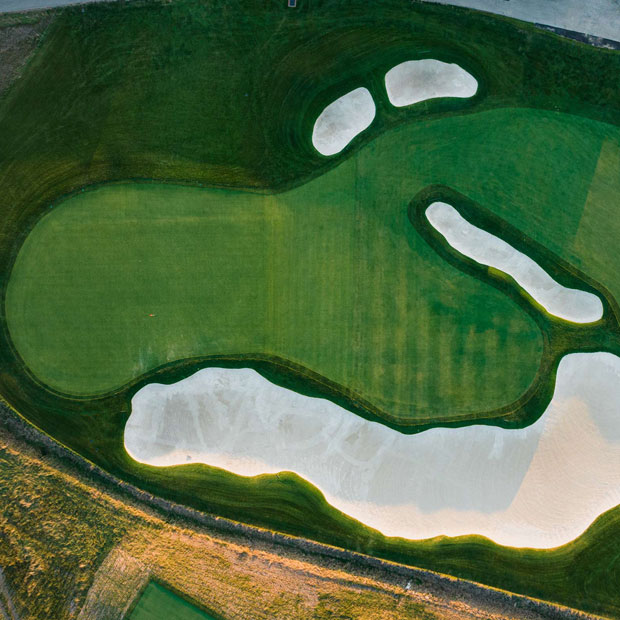Coore & Crenshaw to Renovate the Pines Course at the International
After buying the International Golf Club & Resort, Escalante Golf has hired Coore & Crenshaw to redesign the Pines Course


Last year, the International Golf Club & Resort—a 36-hole private facility in Bolton, Massachusetts—was in trouble. The club closed in March and filed for Chapter 11 bankruptcy in May. Over the past couple of months, however, the International has been mounting a comeback. Escalante Golf purchased the club in a bankruptcy sale, and now the design firm Coore & Crenshaw has agreed to renovate the International’s Pines Course.
In an interview with The Fried Egg, Bill Coore said work on the Pines is “tentatively scheduled” to begin in the fall of 2022. He and partner Ben Crenshaw plan to reroute the course, using some existing corridors and green sites but effectively installing a new design on the forest property.
Two years ago, at the request of a different prospective owner, Coore visited the International, walked the Pines Course, and mapped out an alternate routing.
“I walked it two or three times, the existing course,” he said, “and I came to the conclusion that it probably would not be a restoration project. I would probably just view this as a landscape that seemed to be very interesting and readily adaptable for golf. Therefore, how would you lay out a course here?”
The current version of the Pines dates back to the 1950s, when Geoffrey Cornish designed it with the help of Boston golf legend Francis Ouimet. Later, Robert Trent Jones renovated and lengthened the course, and to this day, the Pines is regarded as the longest 18-hole layout in the United States, at 8,325 yards.
“With all due respect to Mr. Cornish, who is one of the most delightful people I’ve ever met, and then Mr. Jones, who was there afterward and did a lot of work on the course,” Bill Coore said, “I thought the site was really interesting for golf, but I wasn’t particularly enamored with the course itself. And I think maybe a significant part of that was that they had tried so hard to make the holes inordinately lengthy, to the point of just having a lot of very awkward situations—extreme walks from one green backward to the other tee and that sort of thing.”
Coore suspects that the Pines Course has changed a great deal since Geoffrey Cornish first laid it out in the Massachusetts woods. “The more I walked and looked at it, and the more I talked to people,” Coore explained, “I don’t know that there was that much left of Mr. Cornish’s course. It just seemed like it had been worked on a lot.”
The site has plenty of potential. Nestled inside the routing of Tom Fazio’s Oaks Course, the Pines weaves through mature pines and bounds over dramatic, sometimes abrupt landforms. “Perhaps most importantly,” Coore added, “it’s almost a sandy, bank run gravel-type soil composition, so the drainage is excellent. It’s the soil type to work with if you were trying to sculpt features. It’s fantastic.”
For the golf course archaeologists among us, Coore & Crenshaw’s renovation of the Pines Course will have a wonky appeal similar to that of the firm’s Sheep Ranch project at Bandon Dunes: it will reveal how two different, important architects approached the same property.
Geoffrey Cornish himself was something of an archaeologist, co-authoring with Ron Whitten a pathbreaking historical survey of golf course architecture. Cornish died in 2012, and Bill Coore will think of him often as the work at the International gets underway.
“I think if he were standing here,” Coore said, “he would probably say, ‘Bill, Ben—this is a nice site. Go see what you can do with it.’ I could be wrong, but having been around him a bit, that’s my sense.”
Leave a comment or start a discussion
Engage in our content with thousands of other Fried Egg Golf Members
Engage in our content with thousands of other Fried Egg Golf Members
Get full access to exclusive benefits from Fried Egg Golf
- Member-only content
- Community discussions forums
- Member-only experiences and early access to events





.webp)





Leave a comment or start a discussion
Lorem ipsum dolor sit amet, consectetur adipiscing elit. Suspendisse varius enim in eros elementum tristique. Duis cursus, mi quis viverra ornare, eros dolor interdum nulla, ut commodo diam libero vitae erat. Aenean faucibus nibh et justo cursus id rutrum lorem imperdiet. Nunc ut sem vitae risus tristique posuere. uis cursus, mi quis viverra ornare, eros dolor interdum nulla, ut commodo diam libero vitae erat. Aenean faucibus nibh et justo cursus id rutrum lorem imperdiet. Nunc ut sem vitae risus tristique posuere.